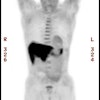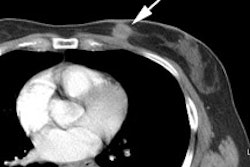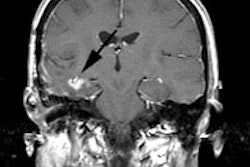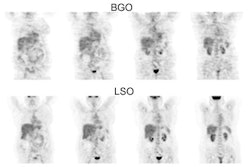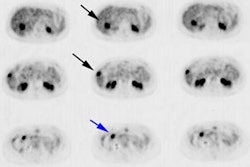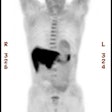J Nucl Med 1995 Oct;36(10):1766-74
Positron tomographic assessment of estrogen receptors in breast cancer:
comparison with FDG-PET and in vitro receptor assays.
Dehdashti F, Mortimer JE, Siegel BA, Griffeth LK, Bonasera TJ, Fusselman MJ, Detert DD,
Cutler PD, Katzenellenbogen JA, Welch MJ.
The purpose of this study was to assess the results of PET with 16 alpha-[18F]fluoro-17
beta-estradiol (FES) and [18F]fluoro-2-deoxy-D-glucose (FDG) to validate the concordance
between tumor estrogen-receptor (ER) status as determined by FES-PET and in vitro assays
and to assess the relationship between tumor metabolic activity determined by FDG-PET and
tumor ER status, both of which may provide information about tumor aggressiveness and
prognosis. METHODS: We studied 32 patients with primary breast masses and 21 patients with
clinical or radiological evidence of recurrent/metastatic breast carcinoma. A diagnosis of
breast carcinoma was subsequently proven in 43 patients (24 primary, 15 metastatic and 4
recurrent tumors). In vitro assessment of ER status was available for 40 malignant lesions
(23 primary and 17 metastatic/recurrent). The patients underwent PET with both FES and
FDG, and the uptake of each tracer within each lesion was evaluated qualitatively as well
as semiquantitatively using the standardized-uptake-value (SUV) method. RESULTS: We found
good overall agreement (88%) between in vitro ER assays and FES-PET. This degree of
agreement is similar to that observed between replicate in vitro assays (with discordances
due to interlaboratory, interassay and specimen variability). We were, however, unable to
demonstrate any significant relationship between tumor FDG uptake and ER status or between
tumor FDG and tumor FES uptake in these patients. CONCLUSION: These results indicate that
in vitro ER assays and/or FES-PET provide unique direct information about breast cancer ER
status that cannot be obtained indirectly by FDG-PET.
